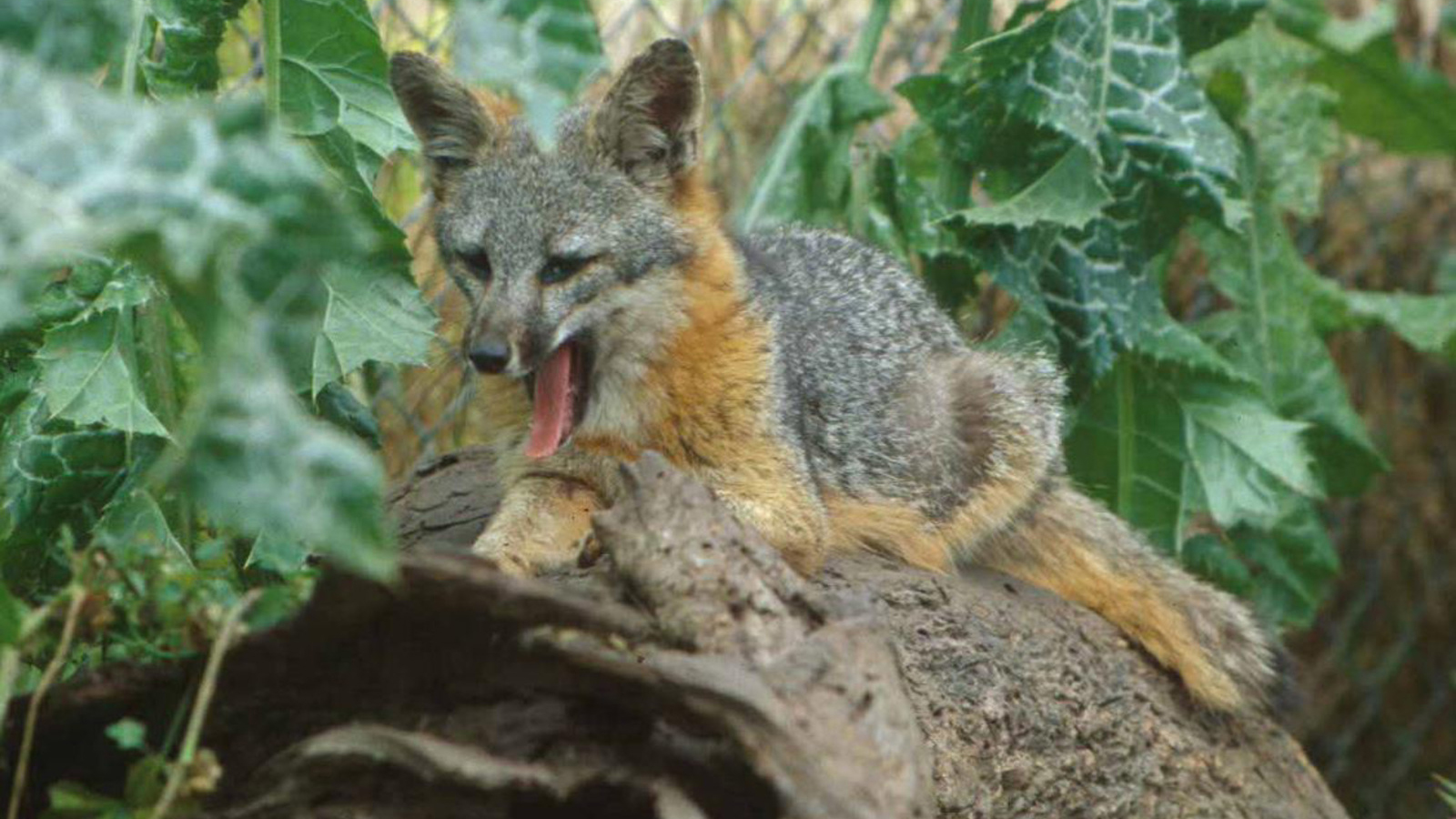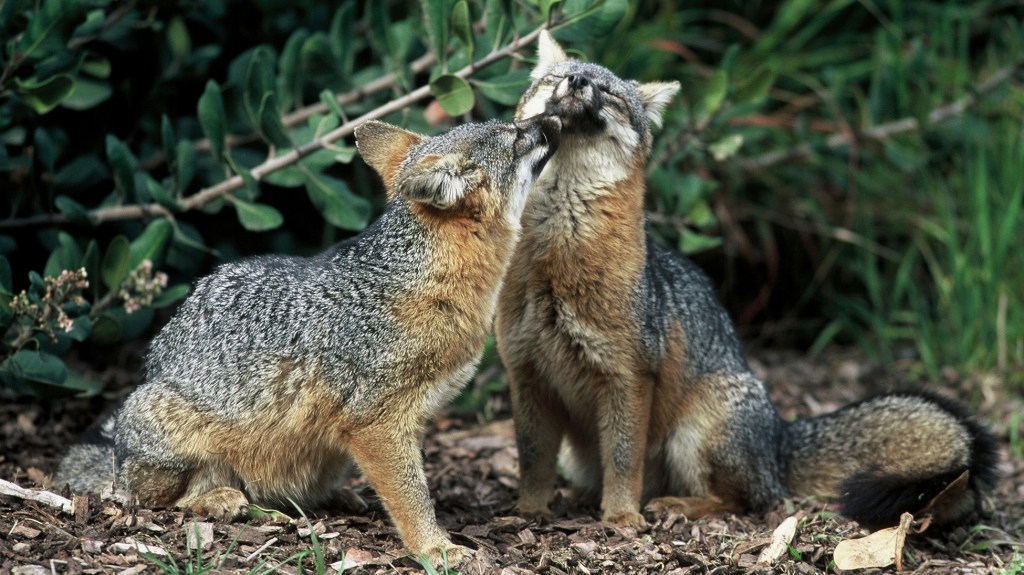On August 11 the U.S. Fish and Wildlife Service delisted three endangered subspecies of island fox, the smallest wild canid in North America and native to six of the eight Channel Islands off southern California.
This was the fastest mammal recovery in Endangered Species Act history and one of the most challenging. Listing happened only 12 years ago.
At 4 to 5 pounds, the island fox is outweighed by most house cats, yet it is the islands’ largest endemic land mammal. It climbs trees to raid bird nests. It has been known to leap onto campers’ laps to grab food, then make off with their shoes, shaking them puppy-style.
The species is native only to the islands of Santa Cruz, Santa Rosa and San Miguel (all within the Channel Islands National Park), San Nicolas and San Clemente (managed by the Navy) and Santa Catalina (managed largely by the Catalina Island Conservancy). Because Santa Catalina gets a million tourists a year and is rife with boat traffic and alien disease vectors, that subspecies was only downlisted to threatened. San Nicolas and San Clemente foxes were never listed.
The recovery, observes USFWS director Dan Ashe, “points to the strength of the ESA.” True; but recovery was well underway years before listing. So precipitous was the decline that early action by the National Park Service, The Nature Conservancy (which owns 76 percent of the largest island, Santa Cruz), the Catalina Island Conservancy, and many collaborators probably kept some subspecies from blinking out well before ESA protection.

A lot has been written about island fox recovery, but little about the ecological morass that, at enormous effort, the partners had to understand and untangle.
An Island Unravels
As recently as the 1990s island foxes were doing okay. Then they crashed. What was happening? There was much to figure out and little time to do it.
Invasive aliens were unraveling ecosystems. For a century feral pigs had been tearing up soil on Santa Cruz, creating ideal conditions for alien-plant invasion. On Santa Rosa cattle and sheep had hammered native vegetation to the point that 80 percent of the island was dominated by alien grasses. And black-tailed deer and Roosevelt elk, introduced by the former owners for hunting, prevented regeneration of many woody natives. Santa Catalina was (and is) blighted by alien deer and feral house cats, both fed by island residents. Rats infested (and infest) Santa Catalina and San Miguel.
But through all this the resilient little foxes had held their own. What was suddenly different?

Research revealed that the main cause of fox mortality on the northern islands (San Miguel, Santa Rosa and Santa Cruz) was predation by golden eagles, historically absent but attracted from the mainland by the ungulate smorgasbord. Foxes, taken as ancillary snacks, were especially vulnerable. Having evolved with no predators, they hunted by day and didn’t look up.
If goldens had arrived before mid-20th century, they’d likely have been run off by bald eagles, which prefer marine-based prey. But the islands’ bald eagles had been extirpated by DDT dumped into the Southern California Bight by Montrose Chemical Company.
Gradually, the prescription for recovery of foxes became clear.
They needed protection from golden eagles, so captive-breeding facilities were established. Golden eagles had to be captured and relocated to the mainland; and the ungulate food supply that had drawn them to the islands and was keeping them there needed to be eliminated. Finally, as a probable means of keeping goldens at bay, bald eagles needed to be reestablished. Given the precariousness of the fox population, all this needed to happen at once.

Aside from the challenges of eradicating the elusive pigs on such a large and rugged island as Santa Cruz, the Park Service and the Conservancy had to divert precious time and resources defending against five lawsuits brought by animal-rights activists committed to the preservation of feral pigs. Fortunately for the foxes, none succeeded.
A rapidly expanding population of wild turkeys, introduced for hunting before Conservancy and park ownership, could have kept golden eagles on Santa Cruz; so they had to go, too. That eradication brought another failed lawsuit from the animal-rights crowd.
By 2006 Santa Cruz was pig- and turkey-free. But next door, on Santa Rosa, deer and elk still served as a magnet for golden eagles. In 1986 the park had bought the island for $30 million, grandfathering hunting rights for deer and elk until 2011.
Sale of guided hunts hadn’t been especially profitable until a 1997 lawsuit brought by the National Parks Conservation Association forced removal of cattle. With cessation of grazing, habitat started to recover. Suddenly elk and deer were growing to trophy size, and hunts were selling for a minimum of $8,000 a pop. So the former owners sought to nullify their signed agreement, eliciting loud support from politicians, hunters and the NRA.

The park stood tall and hired sharpshooters. Now that island, too, is free of introduced ungulates.
Meanwhile, golden eagles were being trapped and relocated to northern California. Remotely triggered “bownets” buried in the dirt and baited with pig carrion, live rabbits or piglets worked for a while, but the birds learned to avoid them, causing exponential increases in effort and cost. Biologists advocated lethal take permits from the Fish and Wildlife Service; but, mindful of the political fallout, the partners wisely declined. A plastic egg with a remotely controlled syringe to deliver tranquilizer was placed in one nest; but a parent flipped it, and the needle stabbed sticks. A tangle of fishing line attached to a dummy fox failed to catch eagles. In 2005-2006 just seven birds, including three hand-captured nestlings, were evacuated at a cost of $600,000. The last pair, seemingly immune to capture, went on a two-year fox-killing spree until they were safely captured with a netgun fired from a helicopter. By 2007, 44 golden eagles (eight of which were nestlings) had been removed from the northern islands.
On Santa Cruz the partners “hacked” young bald eagles to the wild in hope that they’d mature, establish breeding territories and drive away golden eagles. In 2006, for the first time in half a century, bald eagles (two pairs) successfully nested on Santa Cruz. As of 2015 there were 40 bald-eagle nests on the Channel Islands.

On Santa Catalina golden eagles were never a problem. What was killing foxes there was canine distemper, probably introduced by visiting or resident dogs or by raccoons that occasionally stowaway on boats from the mainland. Today, on all islands a “core population” of foxes is vaccinated against rabies and distemper to make sure there’ll be sufficient survivors, if those diseases arrive.
Captive fox breeding, initiated on all four islands in 1998 and hugely successful, ended in 2008.
All manner of native plants, many imperiled and many important to foxes for food and cover, are surging back. So are the foxes. Today population estimates show foxes have increased on San Miguel and Santa Rosa from 15 each to about 600 and 1,000 respectively; on Santa Cruz from 55 to at least 2,000; and on Santa Catalina from 103 to 1,800.

What We Can Achieve Together
“The intense, multifaceted intervention that kicked into gear before listing definitely set the stage for an accelerated recovery,” says Dr. Scott Morrison, director of science for The Nature Conservancy. “The listing then galvanized the partnerships and resources we needed to pull everything off. The take home for me is that this project shows what can happen when people get together and just decide they’re not going let something special go extinct on their watch.”
Dan Ashe had it right when he went on to remark that island fox recovery “demonstrates what we can achieve together.” What it also demonstrates is the vulnerability of island ecosystems to introduced aliens, how quickly island wildlife can spiral toward extinction, and how quickly it can recover when managers are willing to do what’s necessary — even if not forced to do so by law and despite litigious broadsides and political heat.




Such great stories need wide publication in the popular media. It is heart warming, but difficult actions for some had to be taken. Tough love in the wild is often the right medicine.
What a wonderful story. So happy to see the results of everyone working together. As an animal rights person, I understand some of the legal hurdles put up but I believe you did the best you could to achieve the ultimate outcome which is the return of these beautiful, wonderful creatures.
Good job. What about the Island Jays?
This is a success story for the Fox but perhaps the larger success story is about the health of the islands as a whole! The removal of deer, elk, and pigs is a triumph of it’s own. The native plants that survived in the fringes will be able to recover along with the insects that depend upon them. The reintroduction of bald eagles is another success. Our natural world is so complicated with so many interconnections that the benefits will be felt by more than the fox.
Thank you, Nature Conservancy for the restoration work and the lead you take in making meaningful change.
This is why I support the Nature Conservancy. It consistently finds practical ways to eradicate problems that are almost invariably caused by man. It does so in a measured and nonjudgmental way that should be used by the radical ecologists. You cannot eradicate man just because you don’t agree with his effect on the land. What we all need to do is be rational. Extreme environmentalists won’t ever agree with compromise and accommodation. That is why they are going to lose and why they aren’t really relevant,
Love foxes and have had a family of 3 to 11 for most of the last decade in our backyard. I am thrilled to see your efforts to save and encourage these tiny wonders. Nice work, bravo.
An uplifting story that is much welcomed especially in today’s atmosphere of political tension.
Good for you for saving the Channel Island foxes! Keep up the good work.
What are the chances of overpopulation of the foxes on the islands (numbers exceeding resources to support them)?
Will the de-listing drive them close to extinction again, similar to what is happening to wolves all over N. America?
Hooray for the recovery. Evie
What fine thoughtful hard work. It gives me hope it is not too late if we work together wisely and with courage. Thank you all.
Congratulations on a successful program, especially winning out over animal “rights” activists and the hunting lobby. Hurrah for the foxes! (Why would anyone choose an alien feral pig over a native fox?) And hurrah for the recovering native flora.
This is fascinating!
I’d wish I could come back as a person with a career
in this kind of work!
I am so pleased with the National Park Service and The Nature Conservancy working together to rescue ‘The Little Foxes’. This is a special effort with wonderful results. I would like to recommend to who ever is responsible; that no visitors to these islands be allowed to bring dogs onto the island. If you suggest allowing only dogs that can prove by a vaccination certificate that they don’t pose a threat of bringing disease to the islands. I would like to suggest a fee to cover future cost of vaccinations for the little foxes to protect their immunity from these diseases.
People who visit/enjoy nature should be willing to support protecting nature; by not bringing in disease, not destroying habitat, not leaving trash behind, paying to support protection is a small price for any of us who want to enjoy the beauty of nature and to sustain that life.
Thank you again for helping the little foxes!
Gloria Richmond